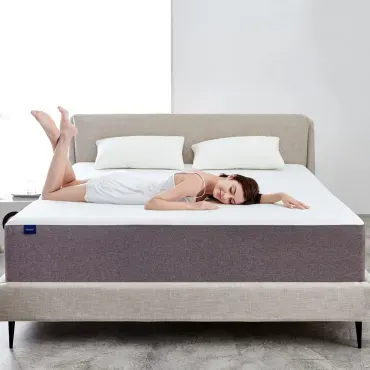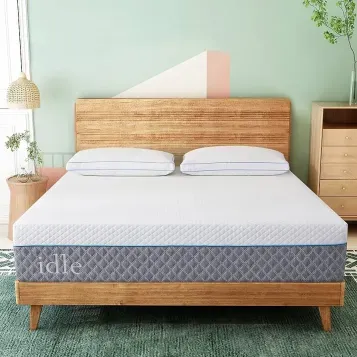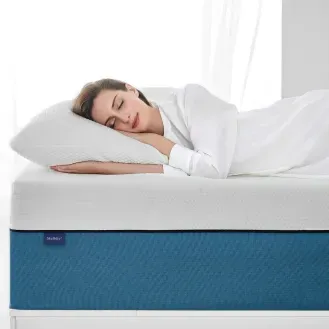Supportive Memory Foam Mattress
So, you’re in desperate need of a good night’s sleep? Look no further, because the Supportive Memory Foam Mattress is here to save the day (or night)!
This miraculous creation, also known as the Green Tea Memory Foam Mattress, is a dream come true for those seeking ultimate comfort and support.
Say goodbye to tossing and turning, and hello to blissful slumber. With its innovative memory foam technology, this bed in a box will contour to your body like a cozy hug from a long-lost friend. No more counting sheep, just undisturbed rest and the sweet dreams you deserve.
Get ready to wake up feeling refreshed and ready to conquer the world, all thanks to the Supportive Memory Foam Mattress.
Benefits of a Supportive Memory Foam Mattress
This image is property of Amazon.com.
Pressure Relief and Spinal Alignment
One of the major advantages of a supportive memory foam mattress is its ability to provide pressure relief and promote proper spinal alignment. The memory foam material molds to the shape of your body, distributing your weight evenly and reducing pressure points.
This helps to alleviate common body aches and pains, such as those in the back, shoulders, and hips. Additionally, the memory foam mattress helps to maintain the natural alignment of your spine, ensuring that it remains in a neutral position throughout the night.
Motion Isolation
If you share your bed with a partner or are easily disturbed by movement during the night, a supportive memory foam mattress is a great choice. Thanks to its unique construction, memory foam minimizes motion transfer.
This means that if your partner tosses and turns, or even gets out of bed, you’re less likely to feel their movements. This leads to a more restful sleep, as you won’t be constantly jostled awake by your partner’s motions.
Durability and Longevity
Investing in a supportive memory foam mattress is a smart long-term decision because of its durability and longevity. Unlike traditional spring mattresses that tend to sag over time, memory foam mattresses are designed to maintain their shape and support for many years.
The high-quality foam used in these mattresses is resilient and can withstand daily use without losing its supportive properties. This means that you won’t have to worry about replacing your mattress every few years, saving you both time and money in the long run.
Hypoallergenic Properties
For those who suffer from allergies or asthma, a supportive memory foam mattress can make a world of difference. Memory foam is naturally resistant to allergens such as dust mites, mold, and pet dander.
This makes it an ideal choice for individuals who are prone to allergic reactions. Furthermore, memory foam is made without the use of harmful chemicals, such as formaldehyde or phthalates, which can aggravate respiratory conditions.
With a supportive memory foam mattress, you can rest easy knowing that you’re sleeping in a clean and allergen-free environment.
Temperature Regulation
One common concern with memory foam mattresses is that they can retain heat and cause you to feel too warm during the night. However, many modern memory foam mattresses are designed with advanced cooling technologies to combat this issue.
Some memory foam mattresses are infused with cooling gel or contain open-cell foam structures that allow for better airflow. These features help to dissipate heat and keep you cool throughout the night. So, if you tend to sleep hot, don’t worry – there are supportive memory foam mattresses out there that will keep you comfortably cool.
Choosing the Right Supportive Memory Foam Mattress
Thickness and Density
When choosing a supportive memory foam mattress, it’s important to consider the thickness and density of the foam. Thicker mattresses generally provide better support and pressure relief, especially for individuals with heavier body weights.
A minimum thickness of four to five inches is recommended for optimal comfort. Additionally, the density of the foam affects its durability and support. Higher-density foams are more durable and tend to offer better support, while lower-density foams tend to be softer and less durable.
Consider your personal preferences and needs when selecting the thickness and density of your memory foam mattress.
This image is property of Amazon.com.
Firmness Level
The firmness level of a memory foam mattress is crucial in determining its comfort and support. The firmness you choose depends on your sleeping position and personal preferences.
For back sleepers, a medium-firm or firm mattress is recommended to maintain proper spinal alignment. Side sleepers typically benefit from a slightly softer mattress that cushions the shoulders and hips.
Stomach sleepers, on the other hand, require a firmer mattress to prevent excessive sinkage and maintain proper alignment. It’s important to find a balance between comfort and support by selecting a firmness level that suits your individual needs.
Certifications and Standards
When shopping for a supportive memory foam mattress, it’s essential to look for certifications and standards that guarantee the quality and safety of the product.
Certifications such as CertiPUR-US® ensure that the memory foam used in the mattress is free from harmful chemicals, such as formaldehyde and heavy metals. This certification also verifies that the mattress has low VOC (volatile organic compound) emissions, contributing to better indoor air quality.
Additionally, certifications like OEKO-TEX® Standard 100 certify that the mattress materials have been tested for harmful substances. Look for these certifications to ensure that you’re making a safe and eco-friendly choice.
Trial Period and Warranty
Since choosing a mattress is a highly personal decision, it’s important to find a supportive memory foam mattress that offers a generous trial period and warranty.
A trial period allows you to sleep on the mattress in the comfort of your own home for a specified period, typically around 100 nights. This gives you ample time to determine if the mattress meets your comfort and support needs.
Additionally, a warranty protects you against manufacturing defects a
nd ensures that you’re investing in a quality product. Look for mattresses with at least a 10-year warranty to have peace of mind knowing that your investment is protected.
Price Range
Supportive memory foam mattresses come in different price ranges to suit various budgets. It’s important to set a budget before starting your search and to consider the value and long-term benefits of the mattress.
While higher-end memory foam mattresses may come with advanced features and superior durability, there are also affordable options that deliver excellent support and comfort.
Consider your individual needs and balance them with your budget to find the best supportive memory foam mattress that offers the perfect combination of quality and affordability.
Materials Used in Supportive Memory Foam Mattresses
Memory Foam
Memory foam is the key component of supportive memory foam mattresses and is responsible for their unique support and comfort qualities. Memory foam is made from polyurethane, with added chemicals that give it its signature ability to conform to your body shape.
This material reacts to pressure and heat, molding itself to the contours of your body and evenly distributing your weight. It provides excellent support, reduces pressure points, and helps maintain proper spinal alignment.
Polyurethane Foam
In addition to memory foam, supportive memory foam mattresses often feature layers of polyurethane foam. Polyurethane foam offers support and adds to the overall structure and durability of the mattress.
Different types of polyurethane foam, such as high-density foam or transitional foam, may be used in different sections of the mattress to provide specific support or comfort properties.
This image is property of Amazon.com.
Natural and Organic Materials
For those concerned about the environmental impact of their mattress, there are supportive memory foam mattresses available that incorporate natural and organic materials.
These mattresses may feature natural latex foam, which is sourced from rubber tree sap and offers a bouncier and more responsive feel compared to memory foam. Additionally, organic cotton or wool may be used in the mattress cover or as fire retardant barriers, providing a natural and sustainable alternative to synthetic materials.
Fire Retardants
To meet safety regulations, memory foam mattresses are typically treated with fire retardants. However, it’s important to note that not all fire retardants used are environmentally friendly or safe for personal health.
Look for supportive memory foam mattresses that use natural fire retardant barriers, such as wool, which provide effective protection without the use of harmful chemicals. This ensures a safer and more eco-friendly sleep environment.
Types of Supportive Memory Foam Mattresses
Traditional Memory Foam Mattress
The traditional memory foam mattress is the classic and most widely known type of memory foam mattress. It features a top layer of memory foam that provides the contouring support and pressure relief that memory foam is known for.
These mattresses often have additional layers of supportive foam underneath the memory foam layer to enhance overall comfort and durability. Traditional memory foam mattresses are a great choice for those seeking excellent pressure relief and body contouring.
Gel Memory Foam Mattress
Gel memory foam mattresses are designed to address the heat retention issue often associated with traditional memory foam.
These mattresses are infused with cooling gel beads or gel capsules that help regulate body temperature and dissipate heat. The gel helps to draw heat away from your body, keeping you cool and comfortable throughout the night.
Gel memory foam mattresses provide the same contouring support and pressure relief as traditional memory foam mattresses, with the added benefit of enhanced temperature regulation.
Copper-Infused Memory Foam Mattress
Copper-infused memory foam mattresses combine the benefits of memory foam with the antimicrobial properties of copper. Copper has natural cooling properties and is known to have antimicrobial and odor-reducing properties.
When infused into the memory foam, copper particles can help inhibit the growth of bacteria, fungi, and mold, creating a cleaner and more hygienic sleep environment. Copper-infused memory foam mattresses are an excellent choice for allergy sufferers or those who prioritize hygiene and odor control.
Plant-Based Memory Foam Mattress
Plant-based memory foam mattresses are made using a portion of plant-based materials, providing a more eco-friendly alternative to traditional memory foam mattresses.
These mattresses replace a portion of the petroleum-based materials found in traditional memory foam with natural oils derived from plants.
The result is a memory foam that is more breathable, environmentally friendly and produces fewer VOC emissions. Plant-based memory foam mattresses offer the same supportive and pressure-relieving properties as traditional memory foam mattresses, with the added benefit of a reduced carbon footprint.
Factors Affecting Support and Comfort
This image is property of Amazon.com.
Body Weight and Sleeping Position
Your body weight and sleeping position play a significant role in determining the level of support and comfort you need from a memory foam mattress.
Heavier individuals may require thicker and denser mattresses to adequately support their weight and prevent excessive sinkage. Back sleepers generally require a medium-firm to firm mattress to maintain proper spinal alignment. Side sleepers benefit from a slightly softer mattress that cushions the shoulders and hips.
Stomach sleepers should choose a firmer mattress to prevent the sinking of the hips and potential misalignment of the spine. Consider your body weight and preferred sleeping position when selecting a supportive memory foam mattress.
See also The Comfort and Convenience of Wall Beds: Why You Should Consider a Murphy Bed for Your Home
Mattress Foundation
The foundation or base on which your memory foam mattress sits can impact its support and comfort. A solid foundation, such as a sturdy platform bed or a solid slatted base, provides optimal support and prevents sagging.
If you prefer a more traditional bed frame with a box spring, ensure that the box spring is in good condition and doesn’t sag, as this can affect the support and longevity of your mattress.
Make sure to follow the manufacturer’s recommendations regarding compatible foundations to maximize the performance and lifespan of your supportive memory foam mattress.
Bedding and Mattress Toppers
The bedding and mattress toppers you choose can also affect the support and comfort of your memory foam mattress. Use a fitted sheet with deep pockets that can accommodate the thickness of your mattress without putting unnecessary strain on the foam.
Consider using a mattress protector or waterproof cover to protect your mattress from spills and stains, which can compromise its performance and longevity.
If desired, you can also add a mattress topper for additional plushness or cooling properties. Just make sure to choose a topper that doesn’t interfere with the contouring and support of your memory foam mattress.
Maintenance and Care for Supportive Memory Foam Mattresses
Regular Cleaning
To keep your supportive memory foam mattress in optimal condition, it’s important to perform regular cleaning. Start by removing any bedding and vacuuming the surface of the mattress to remove dust, debris, and allergens.
For stains or spills, spot-clean the affected area using a mild detergent mixed with water. Avoid using harsh chemicals or excessive moisture, as they can damage the memory foam. Allow the mattress to dry completely before covering it with clean bedding.
Odor Elimination
When you first receive a new memory foam mattress, it may have a slight odor, known as off-gassing. This is a normal occurrence and happens when volatile chemicals escape from the foam. To eliminate the odor, air out the mattress in a well-ventilated room for a few days before using it.
You can also place the mattress in a room with a fan or open window to expedite the off-gassing process. If the smell persists, lightly sprinkle baking soda on the surface of the mattress, let it sit for a few hours, and then vacuum it up.
Rotation and Flipping
Unlike traditional spring mattresses, memory foam mattresses are not designed to be flipped. However, rotating your mattress periodically can help distribute the wear and prevent the formation of permanent body impressions.
Consult the manufacturer’s guidelines to determine how often you should rotate your specific memory foam mattress. Generally, rotating the mattress 180 degrees once or twice a year should suffice to maintain its integrity and comfort.
This image is property of Amazon.com.
Protection from Moisture and Stains
Protecting your supportive memory foam mattress from moisture and stains is essential to maintaining its performance and longevity. Use a waterproof mattress protector or a mattress pad with moisture-wicking properties to guard against spills, accidents, and perspiration.
These protectors create a barrier between the mattress and moisture, preventing it from seeping into the foam and potentially causing damage or mold growth. Remember to wash and replace the protector regularly to keep it clean and effective.
Replacing and Recycling
While memory foam mattresses are known for their durability, they will eventually wear out over time. It’s important to recognize the signs of degradation, such as sagging, loss of support, or excessive wear on the surface. If your memory foam mattress is no longer providing the support and comfort it once did, it may be time to replace it.
When disposing of your old mattress, consider recycling options in your area. Many mattress retailers and recycling centers offer services to properly recycle foam mattresses, reducing their environmental impact.
Common Concerns and Misconceptions about Supportive Memory Foam Mattresses
Heat Retention
One concern often associated with memory foam mattresses is heat retention. While earlier versions of memory foam had a reputation for trapping heat, many modern memory foam mattresses are designed with cooling features to combat this issue.
Look for mattresses with cooling gel infusions, open-cell foam structures, or breathable cover fabrics. Additionally, using cooling sheets, breathable mattress protectors, or adjusting the room temperature can further enhance heat dissipation and promote a cooler sleep environment.
Off-Gassing
When memory foam mattresses are unpacked for the first time, they may release a slight odor, commonly referred to as off-gassing. This is a normal occurrence and is caused by the release of volatile organic compounds (VOCs) trapped within the foam.
The odor is generally harmless and fades over time. To expedite the off-gassing process, you can air out the mattress in a well-ventilated room for a few days or use natural odor-absorbing materials such as baking soda.
Sagging or Loss of Support
Contrary to popular belief, supportive memory foam mattresses are designed to resist sagging and maintain their shape and support for an extended period. However, over time, natural body impressions may form due to the foam conforming to your individual shape.
These impressions are usually normal and should not affect the overall support and comfort of the mattress. To minimize the risk of excessive sagging, ensure that you rotate the mattress periodically and use a supportive foundation or base.
Break-in Period
Some users may find that their memory foam mattress feels different initially compared to their expectations. This is because memory foam may have a break-in period, during which it adjusts to your body shape and temperature.
It can take a few weeks for the mattress to fully conform and provide optimal support and comfort. During this time, it’s important to give your body and the mattress a chance to adapt before making a judgment on its suitability for you.
Weight Limit and Motion Transfer
Supportive memory foam mattresses typically have weight limits specified by the manufacturer to ensure proper support and longevity. It’s important to adhere to these weight limits to prevent premature sagging or damage to the mattress.
Additionally, memory foam mattresses excel at minimizing motion transfer, which is beneficial for couples or individuals who are easily disturbed by movement during sleep. The foam absorbs and isolates motion, reducing the chance of it being felt across the mattress.
Health Benefits of a Supportive Memory Foam Mattress
Alleviating Body Aches and Pains
The pressure-relieving properties of a supportive memory foam mattress can help alleviate body aches and pains. The foam molds to your body, reducing the stress on your joints and muscles. This can provide relief from common sources of pain, such as backaches, shoulder pain, and hip discomfort.
By properly supporting your body’s natural curves and distributing your weight evenly, a memory foam mattress can help you wake up feeling refreshed and free of any lingering pain or discomfort.
Improved Sleep Quality
With its ability to reduce pressure points, minimize motion transfer, and promote proper spinal alignment, a supportive memory foam mattress can significantly improve sleep quality.
By providing a comfortable and supportive sleep surface, memory foam mattresses can help you fall asleep faster, stay asleep longer, and experience fewer disruptions during the night.
With better sleep quality, you’ll wake up feeling more rested and rejuvenated, ready to take on the day ahead.
Reduced Allergies and Asthma Symptoms
For individuals who suffer from allergies or asthma, a supportive memory foam mattress can provide relief from asthma symptoms and reduce the presence of allergens.
Memory foam is naturally resistant to dust mites, mold, and pet dander – common triggers for allergies and asthma. By creating a barrier against these allergens, memory foam mattresses help create a cleaner and healthier sleep environment, allowing you to breathe more easily and enjoy a more restful night’s sleep.
Enhanced Spinal Health
Proper spinal alignment is crucial for overall spinal health, and a supportive memory foam mattress can help achieve this. The foam conforms to the natural curves of your spine, providing targeted support and reducing the risk of misalignment.
By supporting the natural S-shape of your spine, a memory foam mattress promotes good posture and reduces the strain on your back. This can help alleviate existing spinal issues and prevent future back problems, ensuring better long-term spinal health.
Eco-Friendly Options for Supportive Memory Foam Mattresses
Sustainable Manufacturing Processes
To reduce environmental impact, many mattress manufacturers have adopted sustainable manufacturing practices. Look for companies that prioritize energy-efficient manufacturing processes, use renewable energy sources, and implement recycling programs.
Additionally, some manufacturers are committed to reducing their carbon footprint by minimizing transportation distances and using local suppliers. By choosing a mattress made by a company with sustainable practices, you can be confident that you’re making an environmentally responsible choice.
Renewable and Recyclable Materials
Supportive memory foam mattresses made from renewable and recyclable materials are an eco-friendly option. Look for mattresses that use natural latex foam derived from sustainably harvested rubber trees.
This type of foam is biodegradable and has a lower environmental impact compared to synthetic materials.
Additionally, seek out mattresses that incorporate organic cotton or wool in their covers or fire retardant barriers. These materials are sourced from organic farms that prioritize sustainable and eco-friendly farming practices.
Certifications and Eco-Labels
Certifications and eco-labels are essential indicators of a mattress’s environmental friendliness. Look for mattresses that have certifications such as CertiPUR-US® or OEKO-TEX® Standard 100, as these ensure that the mattress has been tested for harmful substances and meets strict environmental and safety standards.
Additionally, some mattresses may carry eco-labels such as the Global Organic Textile Standard (GOTS) or the Global Organic Latex Standard (GOLS), indicating that the materials used in the mattress are organic and sustainably produced.
Conclusion
Choosing a supportive memory foam mattress is a significant investment in your sleep quality and overall well-being. The benefits of pressure relief, motion isolation, durability, hypoallergenic properties, and temperature regulation make supportive memory foam mattresses a popular and practical choice.
When selecting a memory foam mattress, consider factors such as thickness, density, firmness level, certifications, trial periods, and warranty coverage.
Pay attention to the materials used in the mattress, including memory foam, polyurethane foam, natural and organic materials, and fire-retardant treatments.
Understand the different types of memory foam mattresses available and how they can cater to your specific needs and preferences. Factors such as body weight, sleeping position, mattress foundation, and bedding should also be taken into account for optimal support and comfort.
Proper maintenance and care, as well as understanding and addressing common concerns and misconceptions, ensure the longevity and performance of your supportive memory foam mattress.
Embrace the health benefits of improved sleep quality, better spinal alignment, reduced allergies and asthma symptoms, and eco-friendly options. By choosing the right supportive memory foam mattress, you’ll be investing in quality sleep and overall well-being for years to come.





